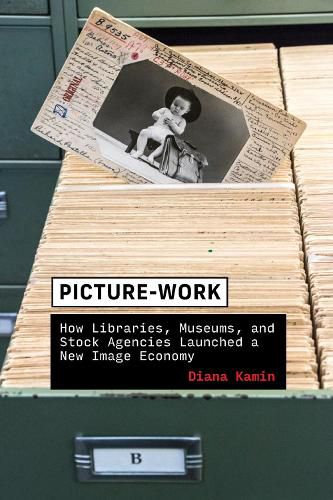Readings Newsletter
Become a Readings Member to make your shopping experience even easier.
Sign in or sign up for free!
You’re not far away from qualifying for FREE standard shipping within Australia
You’ve qualified for FREE standard shipping within Australia
The cart is loading…






How the image collection, organized and made available for public consumption, came to define a key feature of contemporary visual culture.
How the image collection, organized and made available for public consumption, came to define a key feature of contemporary visual culture.
The origins of today's kaleidoscopic digital visual culture are many. In this book, Diana Kamin traces the sharing of photographs to an image economy developed throughout the twentieth century by major institutions. Picture-Work examines how three of these institutions-the New York Public Library, the Museum of Modern Art, and the stock agency H. Armstrong Roberts Inc.-defined the public's understanding of what the photographic image is, while building vast collections with universalizing ambitions. Highlighting underexplored figures, such as the first rights and reproduction manager at MoMA Pearl Moeller and visionary NYPL librarian Romana Javitz, and underexplored professional practices, Diana Kamin demonstrates how bureaucratic work communicates ideas about images to the public.
Kamin artfully shows how the public interfaces with these image collections through systems of classification and protocols of search and retrieval. These interactions, in turn, shape contemporary image culture, including concepts of authorship, art, property, and value, as well as logics of indexing, tagging, and hyperlinking. Together, these interactions have forged a concept of the image as alienable content, which has intensified with the advent of digital techniques for managing image collections. To survey the complicated process of digitization in the nineties and early aughts, Kamin also includes interviews with photographers, digital asset management system designers, librarians, and artists on their working practices.
$9.00 standard shipping within Australia
FREE standard shipping within Australia for orders over $100.00
Express & International shipping calculated at checkout
How the image collection, organized and made available for public consumption, came to define a key feature of contemporary visual culture.
How the image collection, organized and made available for public consumption, came to define a key feature of contemporary visual culture.
The origins of today's kaleidoscopic digital visual culture are many. In this book, Diana Kamin traces the sharing of photographs to an image economy developed throughout the twentieth century by major institutions. Picture-Work examines how three of these institutions-the New York Public Library, the Museum of Modern Art, and the stock agency H. Armstrong Roberts Inc.-defined the public's understanding of what the photographic image is, while building vast collections with universalizing ambitions. Highlighting underexplored figures, such as the first rights and reproduction manager at MoMA Pearl Moeller and visionary NYPL librarian Romana Javitz, and underexplored professional practices, Diana Kamin demonstrates how bureaucratic work communicates ideas about images to the public.
Kamin artfully shows how the public interfaces with these image collections through systems of classification and protocols of search and retrieval. These interactions, in turn, shape contemporary image culture, including concepts of authorship, art, property, and value, as well as logics of indexing, tagging, and hyperlinking. Together, these interactions have forged a concept of the image as alienable content, which has intensified with the advent of digital techniques for managing image collections. To survey the complicated process of digitization in the nineties and early aughts, Kamin also includes interviews with photographers, digital asset management system designers, librarians, and artists on their working practices.